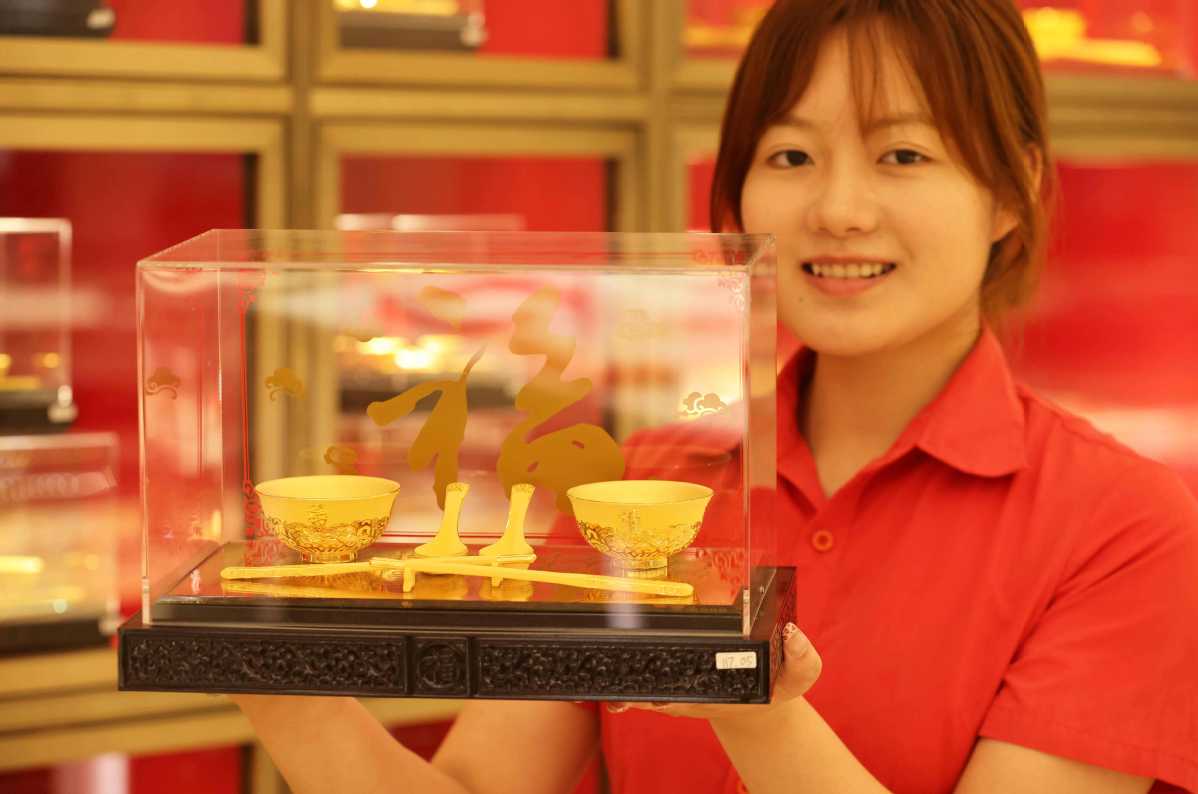Gold prices may rise further in '25

An employee shows gold ornaments at a jewelry firm's display hall in Hangzhou, Zhejiang province. NI LIFANG/FOR CHINA DAILY
Gold prices may rise to $2,800 per ounce by year-end and could even reach $3,000 next year, according to recent estimates by financial services provider UBS.
Factors driving gold price hikes include the rate-cutting cycle started by the US Federal Reserve and major central banks, a weakening US dollar index and ongoing geopolitical risks.
"Meanwhile, many central banks continued to buy gold, which has buoyed investor sentiment. Overall market positions remain low, providing significant room for increased holdings, and institutional investors' willingness to buy gold is increasing," said Sharon Ding, head of China Basic Materials at UBS.
Gold prices have reached record highs this year. The average London Bullion Market Association (LBMA) pm auction gold price for the third quarter was 28 percent higher year-on-year at a record $2,474 per ounce, according to calculations by the World Gold Council (WGC).
Total gold supply increased by 5 percent year-on-year to a record 1,313 metric tons in the third quarter, WGC data showed.
Ding also noted that the outcome of the US election could impact gold prices, leading to short-term risks of a pullback.
Under a high gold price environment, different gold assets have shown varying market performances. In the third quarter, global bar and coin investments (269 tons) decreased by 9 percent year-on-year, while gold jewelry consumption (459 tons) dropped by 12 percent year-on-year despite growth in India. Global gold exchange-traded funds saw an inflow of 95 tons.
Central banks' gold buying pace (net 186 tons) slowed in the third quarter, but year-to-date purchases were consistent with 2022 and remain widespread, WGC said.
China is a major gold consumer. Despite the impact of high gold prices, the WGC reported recently that seasonal factors have led to a 19 percent quarter-on-quarter increase in gold jewelry demand in the Chinese market from July to September. The council anticipated a potential rebound in gold jewelry demand throughout the fourth quarter.
In the first nine months, total gold jewelry demand in China reached 373 tons, down 23 percent year-on-year, impacted by high gold prices.
Demand for gold bars and coins also slowed, totaling 62 tons in the third quarter, marking a 22 percent quarterly decline and a 24 percent annual decrease.
Wang Lixin, regional CEO of WGC China, said, "Factors contributing to this downturn include a higher baseline from the same period in the previous year, the appreciation of the Chinese renminbi and domestic assets (particularly toward the end of the third quarter), and the stabilization of domestic gold prices at elevated levels for much of the quarter."
Despite this, demand for gold bars and coins remained strong from the start of the year to the present, totaling 253 tons and reaching a peak not seen since 2013.
"There is typically increased demand for wedding jewelry, especially gold, in the fourth quarter. The upcoming Spring Festival holiday is also prompting retailers to replenish their stocks for gold jewelry, providing seasonal support for gold jewelry demand in this period," Wang said.
"Additionally, the government recently introduced a set of favorable economic stimulus policies, which may strengthen future consumption of gold jewelry. However, uncertainties persist regarding the impact of high gold prices and the effectiveness of such stimulus measures in boosting consumer confidence. Furthermore, ongoing industry consolidation and the decrease in retail outlets could also potentially result in a decline in physical gold demand."
As for gold coin and bar demand, Wang said further potential cuts in local interest rates might lend support to gold investment demand in the fourth quarter. Nevertheless, as economic stimulus measures are being implemented, investments in gold bars and coins may face competition from other domestic assets. The direction of gold prices will continue to be a crucial factor influencing investment demand.
